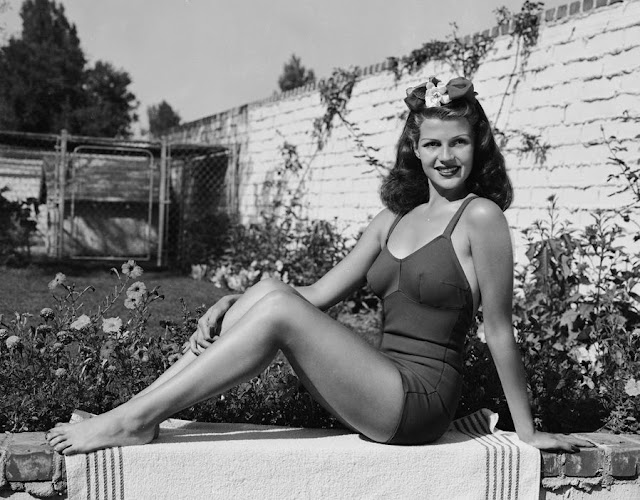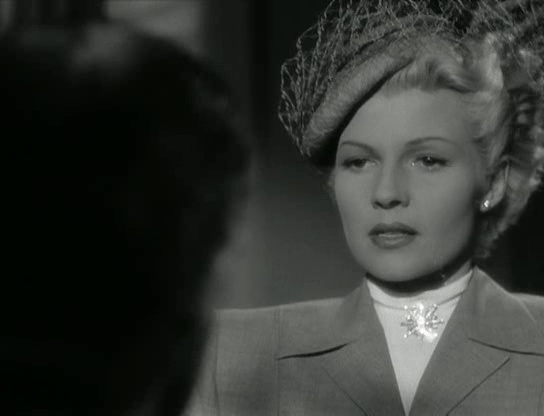İrlandalı Michael O’Hara (Orson
Welles) serserilerin elinden kurtardığı Elsa Bannister’a (Rita
Hayworth) aşık olur. Kadın da ona ilgi gösterir ve avukat kocasıyla (Everett Sloane) beraber
seyahat ettikleri yatın mürettabatına katılmasını ister. Yolculuğun
başlamasıyla entrikalar silsilesi hız kazanır.
Orson Welles’in yazdığı, yönettiği ve oynadığı bir film.
Sherwood King’in “If I Die Before I Wake”
kitabından uyarlama.
Noir film unsurları kullanılıyor kullanılmasına ama beceriksizce. “Femme fatale” rolünün yakıştığı sarışınlaştırılmış Hayworth ve eşi rolündeki Everett Sloane iyi seçimler fakat yürümeyen bir şeyler var. Mesela Akvaryum sahnesi gibi bazı sekanslar fazla deneysel kaçıyor. Meksika yolculuğu kısmı noir film havasını dağıtıyor. Mahkeme sahnesi yine bu tarzda eğreti duruyor. Galiba Stilize sahneler "noir" havasına bir şey katmıyor. Hikaye yeterince gizemli değil ve merak uyandırmıyor. Sözgelimi sinematografik açıdan daha düz bir film olan Malta Şahini'ndeki (1941) çekiciliğin onda biri yok. Özetle bana göre değilmiş. Ancak Rita Hayworth güzelliğinin hatırına
seyredebildim
Filmin başında genç adamın sigara ikramını kullanmamasına
karşın alıp mendilinin arasına özenle yerleştirmesi hanımefendilik örneği
olarak hatırlanacak sahnelerden biriydi. Yalnız ilerleyen sahnelerde Elsa'nın sigara içtiği de gözümden kaçmadı. Belki de güvenilmeyecek bir kadın olduğuna işaret eden bilinçli bir tutarsızlıktı.
Aslında Şangay’la bir ilgisi yok. Elsa bir süre orada kalmış
ve finalde bir Çin gösterisi var sadece. İlginç gözüksün diye kullandılar
herhalde.
Orson Welles bu filmi Rita Hayworth ile evliliklerinin
sonuna doğru çekmiş. Zaten bittikten kısa bir süre sonra ayrılmışlar.
Bu hafta Alzheimer ve
Terry Pratchett’tan bahsetmiştim. Rita
Hayworth’ün ALZ sonucu kaybedildiğini öğrenmek üzücü bir rastlantı oldu. Başarısız
5 evliliğin ardından son yıllarında kızı yanında olmuş.
Everett Sloane Broadway’de başlar. Radyo oyunlarında başarı
kazanır. Borsada çalışır ama 1929’da çökünce aktörlüğe dönmek zorunda kalır. Sinemaya
Orson Welles’in Citizen Kane’i ile adım atar. Birçok dizi ve filmde oynar.
Gözleri kötüleşince 55 yaşında çok sayıda barbitürat alarak intihar eder.
According to Orson Welles, this film grew out of an act
of pure desperation. Welles, whose Mercury Theatre company produced a musical
version of "Around the World in 80 Days," was in desperate need of
money just before the Boston preview. Mere hours before the show was due to
open, the costumes had been impounded and unless Welles could come up with
$55,000 to pay outstanding debts, the performance would have to be canceled. Stumbling
upon a copy of "If I Die Before I Wake," the novel upon which this
film is based, Welles phoned Harry Cohn, instructing him to buy the rights
to the novel and offering to write, direct and star in the film so long as Cohn
would send $55,000 to Boston within two hours. The money arrived, and the
production went on as planned.
 |
| Harry Cohn ile |
Near the end of shooting, Orson Welles told
Columbia executives that he wanted a complete set repainted on a Saturday for
shooting on Monday. Columbia exec Jack Fier told Welles it was impossible,
because of union rules and the expense that would be incurred by calling in a
crew of painters to work on a weekend. Welles and several friends broke into
the paint department that Saturday and repainted the set themselves, and when
they were finished they hung a banner on the set that read "The Only Thing
We Have to Fear is Fier Himself". When the union painters arrived at work
on Monday and saw that the set had been repainted by someone else, they refused
to work, threw a picket line around the studio and threatened to stay on strike
until a union crew was paid triple time for the work that had been done (which
was why Fier had refused to authorize the work in the first place). To placate
the union, Fier agreed to pay them what they wanted but put the cost on Welles'
personal bill. In addition, he had the union painters paint a banner saying
"All's Well That Ends Welles".
Columbia Pictures chief Harry Cohn thought the
movie would ruin his star, Rita Hayworth, and held the release of the
picture back for one year. Cohn ordered director Orson Wellesto insert
"glamour" shots (close-ups) of Hayworth. Because of the success of
Hayworth's singing in other films, Cohn ordered filming of the scene where
Hayworth sings "Please Don't Kiss Me."
The yacht on which much of the action takes place was the
"Zaca", which was rented from its owner, Errol Flynn. Flynn
skippered the Zaca between takes, and he can be spotted in the background in a
scene outside a cantina.
Orson Welles' original rough cut of this picture ran 155
minutes. Numerous cuts made by Columbia Pictures executives included a
shortening of the famous "funhouse" finale.
Orson Welles runs past an old Mexican movie poster
of Resurrection (1927) during a chase scene. The film stars Dolores
del Rio, a former girlfriend of Welles'.
Orson Welles was very displeased with the score put
together by the studio-appointed composer. In a test screening, he put a temp
stock score on which was supposed to be a model for the composer. The composer
completely disregarded Welles' precisely laid-out blueprint. In particular, the
final mirror scene was supposed to be unscored, to create the sense of terror.
Orson Welles thought of Everett Sloane as
primarily a radio actor who didn't move particularly well on film, so he
introduced crutches to the character.
When the film was screened for Columbia Pictures
president Harry Cohn, he found it so incomprehensible he offered to pay
$1,000 to anyone who could explain the plot to him. Later he decided to clarify
the film by beginning it with the trial scene and telling the preceding part of
the story in flashbacks, but abandoned the plan because so much new footage
would have had to be shot it would have nearly doubled the film's cost.
Errol Flynn's own pet dachshund is seen in the yacht scenes,
since it is Flynn's yacht Zaca in the film. Flynn also did all the aerial
photography for that film's yacht scenes and is in the film incognito.
The cast was frequently frustrated and confused by arriving
on the set to find Orson Welles rewriting the script from day to day.
His method of working with his actors was often harsh and manipulative. Sometimes
he deliberately rattled them to get nervous, edgy performances. Other times he
would cause them to forget their lines so they could improvise new ones. One
such line that survives on screen was made up on the spot by a flustered Erskine
Sanford as the judge: "This isn't a football game!"
Shooting was delayed whenever Errol Flynn disappeared
for extended lengths of time. His contract stipulated the yacht could not be
used unless he was present.
Rita Hayworth became ill while shooting in
Mexico, and the production had to close down for a month. Orson Welles had
been unfairly criticized for having the film go over budget.
RITA HAYWORTH
RITA HAYWORTH
In person Rita was
shy, quiet and unassuming; only when the cameras rolled did she turn on the explosive
sexual charisma that in Gilda (1946) made her a superstar. To Rita,
though, domestic bliss was a more important, if elusive, goal, and in 1949 she
interrupted her career for marriage - unfortunately an unhappy one almost from
the start - to the playboy Prince Aly Khan. Her films after her divorce
from Khan include perhaps her best straight acting performances, They Came to
Cordura(1959). Beginning in 1960 (age 42), early onset of Alzheimer's disease
(undiagnosed until 1980) limited Rita's ability. The last few roles in her
60-film career were increasingly small. Almost helpless by 1981, Rita was cared
for by her daughter Yasmin Khan until her death at age 68.
Perhaps Gene Ringgold said it best when he
remarked, "Rita Hayworth is not an actress of great depth. She was a
dancer, a glamorous personality, and a sex symbol.
 |
| 1978 |
Part of the reasons for the downward spiral was television,
but also Rita had been replaced by the new star at Columbia, Kim Novak. After a few, rather
forgettable films in the 1960s, her career was essentially over.
On May 27, 1949, she married Prince Aly Khan. Many
people forget that Rita, not Grace
Kelly, was the first movie star to become a princess.
Charlton Heston
wrote about Rita Hayworth's brief marriage to James Hill. Heston and his wife
Lydia joined the couple for dinner in a restaurant in Spain with the director
George Marshall and Rex Harrison, Hayworth's co-star in "The Happy
Thieves." Heston wrote in his memoir that the occasion "turned into
the single most embarrassing evening of my life", describing how Hill
heaped "obscene abuse" on Hayworth until she was "reduced to a
helpless flood of tears, her face buried in her hands". Heston writes how
they all sat stunned, witnesses to a "marital massacre" and though he
was "strongly tempted to slug him" (Hill), he instead simply took his
wife Lydia home when she stood up, almost in tears. Heston wrote, "I'm ashamed of walking away from Miss
Hayworth's humiliation. I never saw her again.".
QUOTES
Arthur Bannister: "Killing you is killing myself. But, you
know, I'm pretty tired of both of us."
Michael O'Hara: "I've always found it very... sanitary to be
broke."
Elsa Bannister: "You need more than luck in
Shanghai."
Arthur Bannister: "You've been traveling
around the world too much to find out anything about it."
Bu içerik Kuzey Kalesi tarafından hazırlanmıştır. .
















































Hiç yorum yok:
Yorum Gönder
Yorumunuzu yazabilirsiniz.